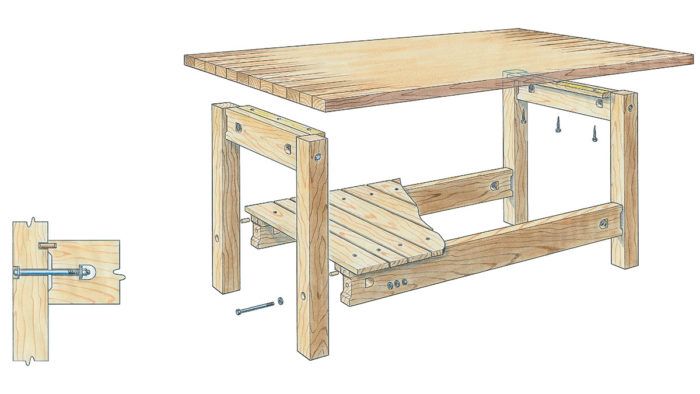
Synopsis: Richard Starr designed a bolt-together workbench that is quick and easy to construct, yet professional looking and absolutely rigid. It consists of four legs and four stretchers held with eight identical joints, which are easy to cut and forgiving due to their bolt fasteners. First you determine size the top, then you make the stretcher joints. Starr explains how to fit the top and add a shelf. A detailed project plan gives the essential dimensions.
As a school woodshop teacher, I must often solve problems on the spur of the moment. That’s how the design for my easy-to-build workbench came to me. A couple of kids wanted to build a bench as a gift for a neighboring preschool. The bench had to be quick and easy to construct, yet professional looking and, above all, absolutely rigid. When all the elements for a simple, bolt-together frame came together in my mind, I hit my palm to my brow. It seemed so obvious. I wondered why I hadn’t thought of it before.
Designing the workbench
The workbench mainly consists of four legs and four stretchers held together with eight identical joints. The joints are easy to cut yet forgiving because they are fastened with common hex-head bolts available at any hardware store. The joint, equally effective in hardwood or cheap construction-grade lumber, is also perfect for many types of knockdown furniture. It’s even solid enough for permanent installations, such as a built-in work counter.
The first step in building the frame is to decide the dimensions of the top. This decision should be based on the bench’s intended use (a carving bench should have a narrower top than a cabinetmaker’s assembly bench) and on the shop space you have available. The bench I built has a 42-in.-wide by 72-in.-long top, good for general woodworking tasks. From these dimensions, I calculated the size of the frame and the length of the stretchers, You can determine the length of each pair of stretchers by subtracting twice the thickness of a leg plus the amount the top will overhang at each end from the length and width of the benchtop. When deciding on the amount of overhang, keep in mind that it’s a good idea to leave plenty of room on all sides, for mounting vises and for clamping things to the top. For example, I chose a 7-in. overhang and used 3-in.-thick by 3-in.-wide legs, so my end stretchers were 22 in. long and the side stretchers were 52 in. long. I made my stretchers from 2×6 stock.
I used soft maple for my bench’s legs, but you can use glued-up hardwood or construction-grade 4x4s. Cut the legs to a length that equals die height of the bench less the thickness of the top. I find that bench height is largely a matter of personal taste. I’m a six-ends than that or you risk the force of the bolt splitting out the endgrain and ruining the stretcher.
From Fine Woodworking #91
For the full article, download the PDF below:
Fine Woodworking Recommended Products

Festool DF 500 Q-Set Domino Joiner

Stanley Powerlock 16-ft. tape measure

Estwing Dead-Blow Mallet






















Log in or create an account to post a comment.
Sign up Log in